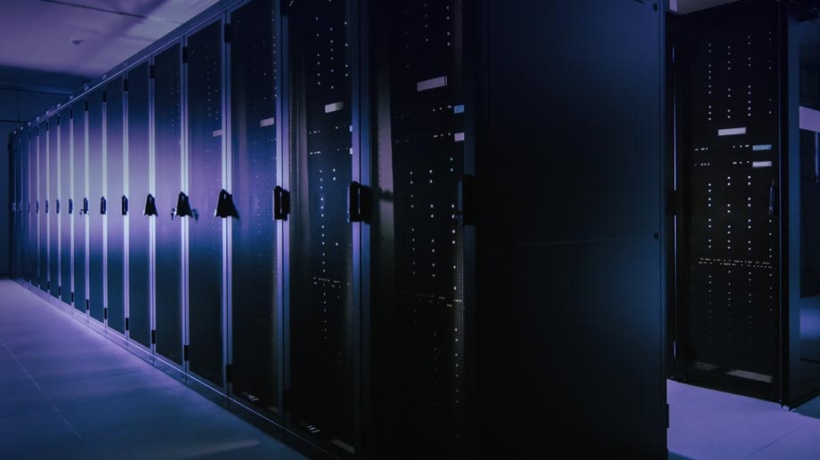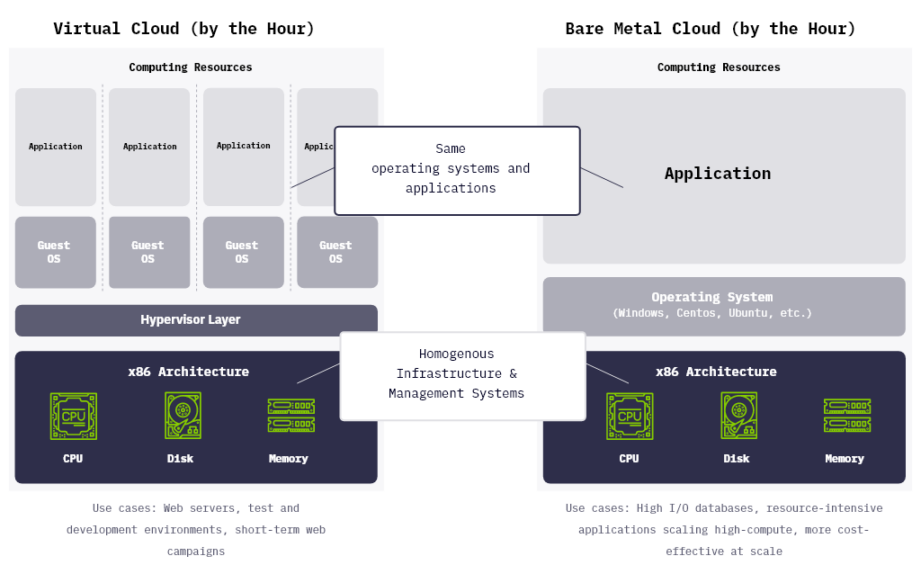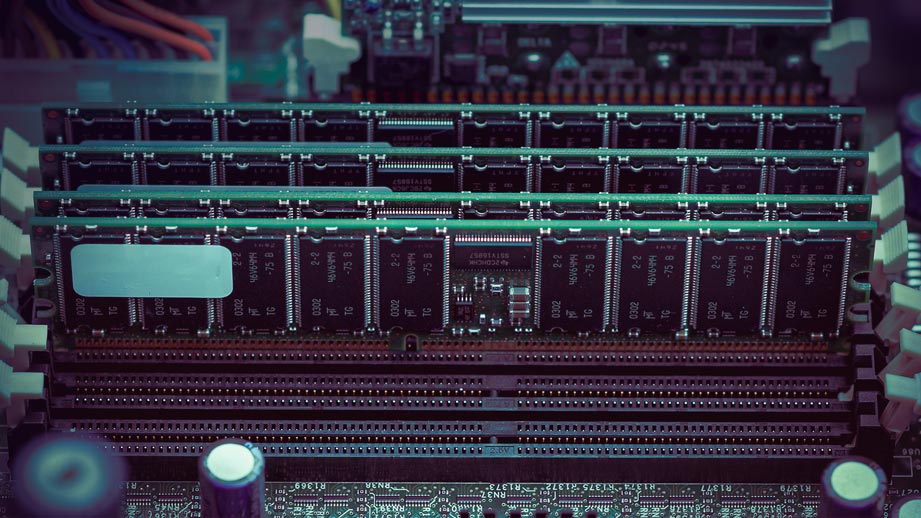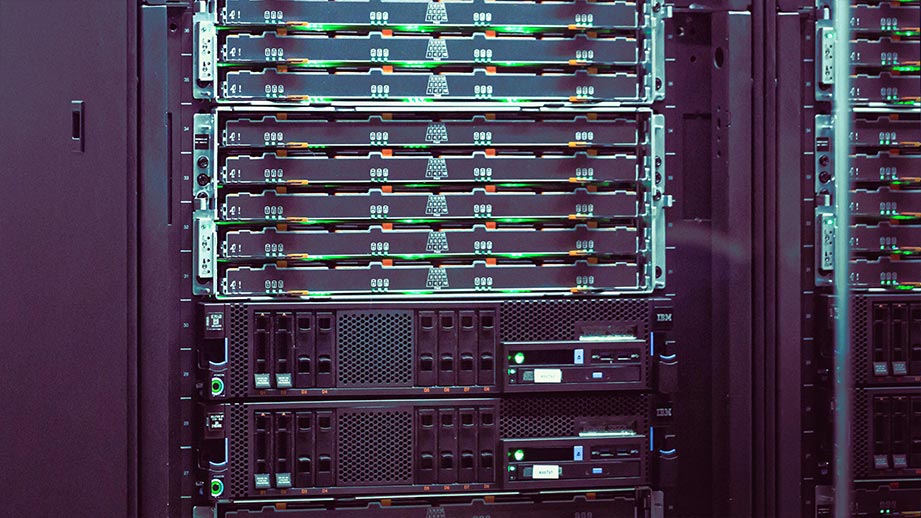What is Bare-Metal Cloud and Where is a Catch?

A bare-metal cloud server is a single-tenant, non-virtualized machine that provides users with full access to the underlying hardware with no overhead. It retains the complete, self-service versatility of the cloud while, at the same time, allowing users to utilize the full processing power of the server’s physical hardware. This article will explain what bare-metal cloud is, how it works, and its advantages over virtualized cloud solutions.
Often, virtualized cloud environments experience performance degradation due to the hypervisor. The hypervisor is the technology that runs the cloud. Hypervisors use additional resources, thereby creating additional overhead that negatively impacts processor-intensive operations. The need to get around those issues but still preserve cloud-like flexibility led to the bare-metal cloud’s development.
Unlike the public cloud, bare-metal cloud servers don’t rely on hypervisors to create separate virtual machines on servers. Bare-metal cloud relies exclusively on physical servers to deliver maximum performance without virtualization overhead.
Hypervisor layers provide visibility, flexibility, and management capabilities required to run multiple virtual machines on a single server and create additional processing overhead. Bare-metal servers eliminate the need for layers by installing the operating system directly onto the disk. This also allows for the configuration of its processor, storage, and memory, which isn’t shared in virtualization cases.
While virtualized cloud infrastructure runs in multiple shared hardware pieces and hosts multiple tenants, a bare-metal server hosts only one. In other words, a bare-metal cloud server is dedicated entirely to one customer and is not shared between customers.
The bare-metal cloud is a subset of the Infrastructure-as-a-Service (IaaS) cloud services. In the IaaS model, the user can lease physical servers from the service providers. Bare-metal cloud incorporates dedicated server hardware along with data center networking, storage, and the facility that hosts it.
So the bare-metal cloud model has several advantages over the standard, virtualized cloud models common among hyperscalers. Let’s delve deeper into the benefits bare-metal cloud offers.
Advantages of Using Bare-Metal Cloud
Both bare-metal cloud and virtualized cloud models offer similar features and advantages. They both help with demand-based and DevOps-based provisioning and pay-as-you-go budgeting. However, the bare-metal cloud has some additional benefits, including hardware control, scalability, and performance optimization.
As previously mentioned, performance degradation can often occur as a result of introducing a hypervisor layer. The bare-metal cloud provides a solution by either complementing or replacing virtualized cloud services with a dedicated server environment that eliminates overhead without sacrificing flexibility, scalability, and efficiency.
Customizability. One significant advantage the bare-metal cloud has is that it’s highly customizable. It allows for NVMe storage for high Input/output operations per second, a specific GPU model, or custom RAM-to-CPU ratio or RAID level. A physical bare-metal server can be built according to the client’s specifications, allowing them to benefit from customized hardware’s additional performance. Although, customizability comes at a price. Customizability limits the ability to scale resources when compared to the virtualized cloud.
Dedicated resources. For applications demanding high data throughput levels, the inherent multi-tenant design of virtualized cloud environments is often constraining, resulting in multi-tenant virtualized public cloud platforms competing with each other. Consequently, they restrict I/O for data-intensive workloads and lead to inefficient and inconsistent performance.
On the other hand, bare-metal servers enable high-performance computing. They are not virtualized and don’t run a hypervisor that creates additional overhead yet still function on a cloud-based service model.
All of the server resources are dedicated to one user, so users don’t have to share resources with other tenants. With the bare-metal cloud, users get direct access to dedicated hardware with all its power.
Hardware control. Bare-metal servers allow complete control of the server hardware. The hardware is fully dedicated, including any additional storage. Bare-metal cloud’s advantage over virtualized cloud environments grants users complete control over the physical processor, memory, and storage resources.
By leveraging administrator-level privileges, users can micromanage the server’s processes, optimize performance, and install additional applications. They can be provisioned and de-provisioned on demand via API or a web-based portal.
Efficient compute resources. Bare-metal servers offer more cost-effective compute resources than their virtualized cloud counterparts in terms of CPU processing power, memory, and storage. Furthermore, depending on the use case, a single bare-metal cloud server can handle larger workloads than similarly sized virtualized servers.
Scalability. The bare-metal cloud allows users to scale their resources by adding additional storage, processing power, and memory to ensure maximum availability when it’s most needed and remove them when they’re no longer required. But, as opposed to virtualized cloud environments, scaling bare-metal cloud resources requires the service provider to add and remove hardware, which takes time physically.
Use Cases for Bare-Metal Cloud
The ever-growing requirements of organizations for flexibility and efficiency had them previously flocking to public cloud infrastructure services and now to the bare-metal cloud. It offers cost-cutting opportunities and capitalization on innovations in technology.
Many companies are switching to bare-metal servers by reducing management overhead and increasing their running speed.
The public cloud can handle many workloads, such as simple web apps and even large databases. However, specialized workloads require more power and agility than only bare-metal cloud servers can offer.
High-performance bare-metal cloud functionality is best suited when clients need to perform short-term, data-intensive operations without latency or overhead delays. These operations include big data applications, analytics, media encoding, rendering, grid computing, and other workloads requiring consistent performance. Let’s take a closer look at some bare-metal cloud use cases.
Building applications. The bare-metal cloud allows developers to build, test, and deploy applications more conveniently. Root server access and native cloud architecture allow them to utilize containerization and orchestration software solutions to treat infrastructure as code.
Furthermore, the bare-metal cloud is often used when computing resource usage is steady and uninterrupted. When the application doesn’t rely on PaaS services, the hardware footprint size is considerable, and when the cost has to be taken into consideration.
Database workloads. When companies need to analyze large amounts of data, virtualized environments are no match for the bare-metal cloud when it comes to performance. Bare-metal servers are ideal for big data workloads. It allows for customization and provisioning and management of physical machines with on-demand flexibility.
Bare-metal cloud is often utilized when particular hardware components are used, or high-performance NVMe disks are integrated. NVMe storage allows users to run demanding applications without compromising on performance. It delivers speed and scalability when analyzing IoT data. In the bare-metal cloud environment, all resources are dedicated to running analytics applications without virtualization overhead.
Game servers. Bare-metal servers are ideal for gaming applications where performance is needed either for raw compute or 3D rendering. As game servers require the least possible latency and maximum I/O throughput, bare-metal servers, with their dedicated hardware, can provide the best performance. Bare-metal cloud not only eliminates latency but, with the speed of bare-metal hardware along with the scalability and cost-effectiveness, meets the high-performance demands coming from the gaming industry today.
Render Farms. As 3D rendering is a processor-intensive operation, utilizing a bare-metal cloud decreases rendering times significantly. While many 3D animation companies still use on-site dedicated servers to achieve performance consistency, the bare-metal cloud environment offers hardware customization and performance optimization by allowing admins to access the servers.
Edge computing. Since edge computing transfers processing power to the edge of the network, closer to the data source, edge computing and bare-metal cloud servers enable companies to gain an advantage in terms of the speed at which they can access data. Containers running on bare-metal servers benefit from lower latency, which is approximately three times lower than running on virtualized machines.
Although bare-metal cloud utilization is not limited to the industries mentioned above as it is also used for AdTech and Fintech applications, video streaming applications, and others, bare-metal servers are generally used for high-performance computing, where any overhead should be avoided, and hardware components have to be customized for performance.
Potential Risks of Using Bare-Metal Cloud Servers
With all the potential benefits that bare-metal servers offer, there are some risks associated with using dedicated servers. A defective CPU, SSD, or a stick of RAM may crash the server. On the other hand, virtualized cloud servers can handle component failure and keep the client’s server running normally. Therefore, to avoid catastrophic consequences resulting from hardware failure requires a bare-metal cloud to have server redundancy.
So What’s the Catch?
The bare-metal cloud provides many benefits when compared to virtualized cloud offerings. But, with all the benefits that the bare-metal cloud has to offer, organizations looking to purchase this service should either have an experienced team capable of working within the bare-metal cloud environment or a quality service provider that can provide support when required.
Companies must have experienced DevOps with the knowledge of using bare-metal technology to benefit from its advantages. Admins and developers who don’t know how to set up applications to reap the benefits of bare-metal servers will probably see no difference in overall performance.
Having a reliable bare-metal service provider can help you avoid all of the challenges with setting up your applications and optimizing performance. Deploying your digital infrastructure with Heficed’s bare-metal cloud offerings ensures that you’ll get not only exceptional performance, security, and scalability but also round-the-clock expert support from our team.






